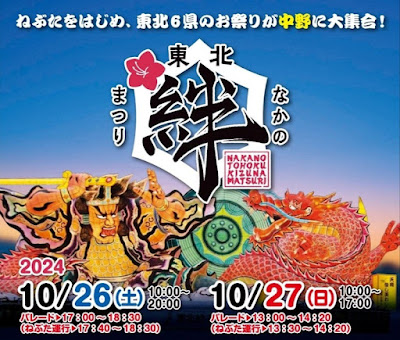Aomori, at the northernmost end of
Japan’s island of Honshu, is renowned for its annual ‘Nebuta Matsuri’ or Nebuta
Festival. ‘Nebuta’ are large, illuminated floats, originally made of wood,
bamboo and coloured or painted paper, and were lit from within by candles.
Nowadays they are made with wire and electric lamps, but they still conform to
the same designs and motifs, often representing historical persons or famous kabuki
actors, as well as gods and mythical beasts.
The key elements of the festival are thought to date back to the Nara Period (710-794), and there are a number of theories concerning its origins, some of which are quite gruesome, relating to historical episodes of regional military conflict and feudal oppression. Although other theories root the festival in Shinto religious practices. As such, it has very likely evolved down the centuries having first arisen in connection to the annual Tanabata festival (7 July) and O-Bon rituals, in which lanterns are floated on rivers in memory of the dead.
 |
| Nebuta scene from 1928 |
Originally carried by one man with a number of supporters, over time the Nebuta lantern floats have grown in size and nowadays they are usually mounted on wheels, requiring large numbers of people to move and operate them during the festival processions. These processions are characteristically made up of large numbers of people dressed in traditional Japanese attire, playing flutes, shaking bells and beating taiko drums, chanting ‘Rasserā’ (ラッセラー), encouraging others to join in.
The main and largest Nebuta Festival takes place in Aomori City, but smaller Nebuta Festivals also take place in different towns and villages across Aomori Prefecture. Other Nebuta Matsuri, or the inclusion of Nebuta in similar festivals, can also be found in different parts of Japan too. Curiously enough, I first saw a Nebuta lantern float in London at the British Museum in November 2001, when one was especially commissioned and built by Japanese crafts people who came to the UK from Aomori as part of "Japan 2001", a year-long series of events celebrating Japanese culture. It was huge and filled the entire space of the large room which used to be the old North Library of the British Library, now the Wellcome Gallery of Living and Dying, just off the Great Court. But my first experience of an actual Nebuta Festival was the one held in Tokyo’s Nakano-ku in October last year (2023). These are some of the pictures I took of the lantern floats.
There was a great atmosphere which grew all the more spectacular after dusk as night fell. The sound of the taiko drums was visceral and could be felt distinctly and almost overwhelmingly in the pit of one’s stomach, resonating with even greater intensity than it was heard, even though the volume itself was ear-splittingly loud. But one of the most impressive sights was watching one person balancing a sail-like rig of lanterns hoisted high on a single bamboo pole – to which extensions were added that progressively raised the sail high above the heads of the people in the procession and those watching from the sidelines, all while deftly balancing them on the palm of one hand, or their forehead, or hip (scroll down to see the pictures posted below). They did accidentally drop one of them on the crowd though, so the sense of drama was quite real!
Nakano Nebuta Festival – properly called the Nakano Tohoku Kizuna Matsuri (なかの東北絆まつり) held in support of the reconstruction of the Tohoku region following on from the earthquake of 2011 – this year will take place on 26-27 October 2024. Further information on the history of Nebuta can be found here.



















No comments:
Post a Comment
Comments do not appear immediately as they are read & reviewed to prevent spam.